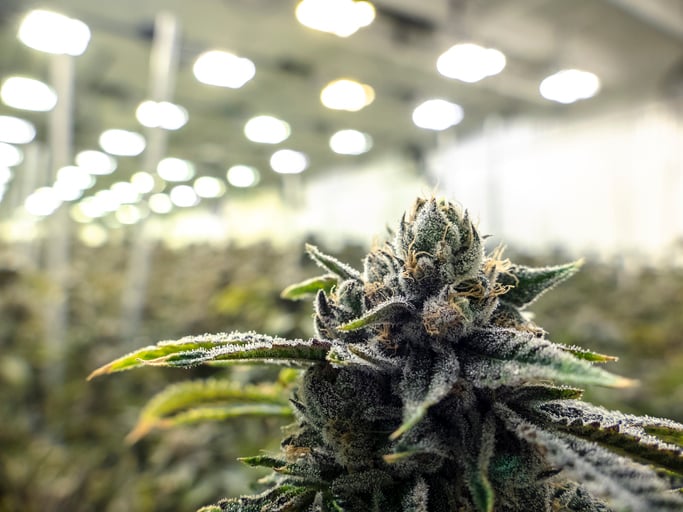Roughly one year ago, the Canadian pot industry could do no wrong. Marijuana stocks in our neighbor to the north were near their all-time highs, and investors were content in the fact that Canada had just become the first industrialized country in the world to legalize recreational cannabis. Sales officially began on Oct. 17, 2018.
However, one year following this launch, Wall Street, investors, and even Canadian cannabis businesses are no longer feeling as confident.

Image source: Getty Images.
Regulatory issues stymie the rollout of recreational marijuana in Canada
According to Cannabis Benchmarks, a financial data provider to the marijuana industry, "only" an estimated 1.1 billion Canadian dollars (about $850 million) of legal marijuana was purchased over the trailing year (Oct. 17, 2018 – Oct. 17, 2019). That might sound like plenty, but it's well off the pace projected by Wall Street and independent analysts.
Cannabis Benchmarks also surmises that, based on an average selling price of CA$10.23/gram for legal Canadian weed during the third quarter, 105,000 kilos is all that was purchased since the green flag waved last year. This number is particularly disturbing given that the peak production potential of Canada's top-15 growers is liable to exceed 3 million kilos per year, on a combined basis, when fully operational. There's no question that these growers are looking to export their product to overseas markets, but anywhere from 800,000 to 1 million kilos per year were fully expected to be consumed within Canada. As of now, domestic consumption is nowhere near this amount.
What's to blame? Although growers have been slow to expand their own cultivation capacity, most of the fault lies with federal and provincial regulators.
For example, Health Canada entered the year with more than 800 cultivation, processing, and sales license applications on its desk awaiting review. Even with aggressive changes being made by the regulatory agency to expedite its cultivation license application review process, this backlog of applications isn't going away overnight.
Maybe an even bigger problem has been the slow approval and licensing process for physical dispensaries in select provinces. In Ontario, for example, just 24 dispensaries are currently open in a province that holds around 14.5 million people. Without ample retail locations, consumers have had to either buy online or purchase from the black market. Many have been choosing the latter, with nearly half of all Canadians admitting to illicit pot purchases since recreational weed was legalized.
While both of these problems are fixable, they're going to take time to resolve. That might mean numerous quarters, if not years, before pot shortages are abated domestically.

Image source: Getty Images.
Could cannabis growers be forced to idle their production?
These early-stage struggles bring to light a very real question that a year ago would have been almost unfathomable given the hype surrounding cannabis. Namely, will pot stocks have to consider or be forced to curb production in light of these regulatory-based supply problems?
We may have been given a clue as to the answer last week. On Friday, Oct. 18, The Green Organic Dutchman (TGODF +0.00%) unveiled a new strategic plan designed to curb its capital spending in the near term, as well as enhance its path to profitability. On the surface, that probably sounds like a great update, especially with the company expected to be generating positive operating cash flow by the second quarter of 2020. But Green Organic Dutchman's update isn't as benign as it sounds.
TGOD, as the company is also known, is expected to be a top-five producer at peak production, with its flagship 820,000-square-foot Valleyfield grow facility helping to push the company to 219,000 kilos annually. However, Green Organic Dutchman's strategic update shows that it's basically idling capacity expansion efforts at Valleyfield until such time as it makes sense to ramp up production. Between the 12,000 kilos of output expected from Ancaster next year and the 10,000 kilos forecast from four grow rooms at Valleyfield, TGOD is only projecting 20,000 to 22,000 kilos of output in 2020. That's substantially lower than analysts and retail investors have been expecting.
Said Brian Athaide, CEO of TGOD:
With the current Canadian legal market being smaller than initially anticipated, mainly due to a slow rollout of retail locations in key provinces, we believe that our revised plan will allow TGOD to right size its production to capture the organic segment, while maintaining optionality to quickly accelerate and expand as more retail locations begin to open.

Image source: Getty Images.
Are these Canadian growers next to cut back on output?
With The Green Organic Dutchman admitting that demand will remain challenging in the near term, this should leave investors to wonder if capacity cuts or forced idling of existing facilities might be in the offing for Canada's other large growers, such as Aurora Cannabis (ACB 2.04%) and Canopy Growth (CGC 6.79%). Aurora and Canopy are the No.'s 1 and 2 in Canada in terms of peak annual output.
If there's one advantage for Aurora Cannabis, relative to Canopy Growth, it's that the company has its joint venture, 1-million-square-foot Aurora Nordic 2 facility in Denmark nearing completion. This grow site, capable of 120,000 kilos a year, will be serving the Scandinavian and western European region of the EU, and not the Canadian market. Thus, a solid chunk of Aurora's production that'll soon come on line should be unaffected by Canada's regulatory woes.
However, close to 500,000 kilos of annual run-rate output for Aurora, and likely a similar figure for Canopy Growth, could be adversely impacted in fiscal 2020. It's likely that Aurora, Canopy, and the rest of the marijuana industry could place some cannabis into inventory, and will likely process some of their dried cannabis and hemp biomass into concentrates, distillates, and resins to be used in cannabis derivatives. But it's unclear what would happen if inventory levels begin to skyrocket. My personal suspicion is it would crater the per-gram price for legal cannabis in Canada, thereby crushing margins.
Furthermore, sending this pot to overseas markets is unlikely given that demand has yet to be satisfied in Canada. Remember, the consumer demand for weed is there in Canada, but the means to get that supply to market through legal channels is what's lacking at the moment.
Although Aurora Cannabis and Canopy Growth have given no indication that they intend to slow-step their capacity expansion projects, it wouldn't be in any way surprising if they eventually followed TGOD's lead and tightened their belts to reduce their cash burn.







